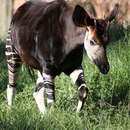Biology
provided by Arkive
Most of the information about the biology of the okapi is from captive animals (2). They are largely solitary (2) and though once thought to be nocturnal (6), are now known to be active during the day (2). They feed largely on leaves, grasses, fruits and fungi, some of which are known to be poisonous. It has been suggested that this is why okapis eat charcoal from burned forest trees, as is evidenced from their dung (2). Carbon, in the form of charcoal, is an excellent antidote for toxin ingestion and recent observations in Zanzibar found red colobus monkeys eating charcoal from native cooking fires and kilns (7). It is also known that many other animals find sources of kaolin, a type of clay, to offset the effects of poisonous leaves and fruit in their diet.
Male and female okapi live in home ranges, but they are not territorial and these ranges overlap (3). From observations on captive animals, it appears that male okapis mark their ranges with urine, by crossing their front legs, urinating on them, and then walking through their range. They will also urinate directly onto plants. Both males and females rub their necks against tree trunks (3).
Mothers will not stray very far after giving birth, so the young okapi will remain close by until at least a few days old, in what is known as a 'follower phase' (3). It then becomes a 'nester' for a number of months, in which it lies in vegetation. During this intensive nesting phase, the calf is extremely efficient in the use of energy, primarily only nursing or sleeping. Towards the end of the intensive nesting phase, the calf can maintain its temperature properly, and so activates its rumens, and defecates for the first time (3). This is thought to be a defence against predators (2). Okapi mothers use infrasonic communication to communicate with their calves. This is sound that is below the range of human hearing – also used by elephants (3).
The young are weaned at six months old although they may continue to take milk for some time afterwards. The males begin developing their horns at about one year and reach their adult size at the age of three. They are believed to reach sexual maturity around two years old (2). Captive individuals have been known to live for up to 33 years (3).
Conservation
provided by Arkive
The okapi is classified as Lower Risk - near threatened by the World Conservation Union (IUCN) Red List of Threatened Species. Its populations are thought to be stable at the present time (1). However, with increased deforestation to provide agricultural areas to feed an increasing human population within the animal's range, more studies of the wild okapi may be needed to accurately assess its conservation requirements (2).
Description
provided by Arkive
Perhaps the most extraordinary fact about the okapi is that it was not known to science until 1901 (4). Its taxonomic name, Okapia johnstoni, honours both its native Central African name (5), and that of the man who first 'discovered' it, Sir Harry Johnston, the British explorer, naturalist and colonial administrator (4). The native pygmies of Central Africa had known of this animal's existence for generations, thinking it was a type of horse, which was how they described it to Sir Henry Morton Stanley (of 'Dr. Livingstone, I presume' fame) (4). In fact, the okapi is a forest-living relative of the giraffe (4).
Although closely resembling a horse, the okapi has a relatively long neck although not as long as its giraffe cousins. The forehead, neck and body are brown, with light tan or grey on the animal's cheeks, throat and chest. Okapi hair is short, slightly oily to the touch and has a delicate scent (3). The hind limbs and upper forelegs have cross-stripes resembling those of a zebra whilst the lower limbs have white 'socks' with brown lines running up the front to the knees, where there is a brown band circling each leg (3). Males have short hair-covered, rearward-facing horns and both sexes have large mobile ears. Females are slightly taller than males (2).
Habitat
provided by Arkive
Okapis are forest animals, found in both dry and rain forest in tropical and sub-tropical latitudes (1) (2).
Range
provided by Arkive
The okapi is found in the Democratic Republic of Congo and in the forested regions of Uganda (1).
Status
provided by Arkive
Classified as Lower Risk - near threatened (LR/nt) on the IUCN Red List 2003 (1)
Threats
provided by Arkive
The main threat to the okapi is loss of its habitat to agriculture and encroaching human settlements. Hunting is also a problem in some regions (1).

